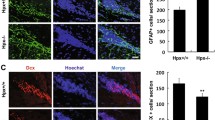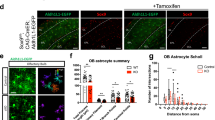Abstract
Adult olfactory neurogenesis plays critical roles in maintaining olfactory functions. Newly-generated neurons in the subventricular zone migrate to the olfactory bulb (OB) and determine olfactory discrimination, but the mechanisms underlying the regulation of olfactory neurogenesis remain unclear. Our previous study indicated the potential of APPL2 (adaptor protein, phosphotyrosine interacting with PH domain and leucine zipper 2) as a modulating factor for neurogenesis in the adult olfactory system. In the present study, we report how APPL2 affects neurogenesis in the OB and thereby mediates olfactory discrimination by using both in vitro neural stem cells (NSCs) and an in vivo animal model—APPL2 transgenic (Tg) mice. In the in vitro study, we found that APPL2 overexpression resulted in NSCs switching from neuronal differentiation to gliogenesis while APPL2 knockdown promoted neurogenesis. In the in vivo study, APPL2 Tg mice had a higher population of glial cells and dampened neuronal production in the olfactory system, including the corpus callosum, OB, and rostral migratory stream. Adult APPL2 Tg mice displayed impaired performance in olfactory discrimination tests compared with wild-type mice. Furthermore, we found that an interaction of APPL2 with Notch1 contributed to the roles of APPL2 in modulating the neurogenic lineage-switching and olfactory behaviors. In conclusion, APPL2 controls olfactory discrimination by switching the fate choice of NSCs via interaction with Notch1 signaling.






Similar content being viewed by others
References
Devanand DP, Michaels-Marston KS, Liu X, Pelton GH, Padilla M, Marder K, et al. Olfactory deficits in patients with mild cognitive impairment predict alzheimer’s disease at follow-up. Am J Psychiatry 2000, 157: 1399–1405.
Chen B, Zhong X, Mai N, Peng Q, Zhang M, Chen X, et al. Interactive effect of depression and cognitive impairment on olfactory identification in elderly people. J Alzheimers Dis 2018, 66: 1645–1655.
Doty RL, Yousem DM, Pham LT, Kreshak AA, Geckle R, Lee WW. Olfactory dysfunction in patients with head trauma. Arch Neurol 1997, 54: 1131–1140.
Yuan TF, Slotnick BM. Roles of olfactory system dysfunction in depression. Prog Neuropsychopharmacol Biol Psychiatry 2014, 54: 26–30.
Ming GL, Song H. Adult neurogenesis in the mammalian central nervous system. Annu Rev Neurosci 2005, 28: 223–250.
Taupin P. Adult neurogenesis in the mammalian central nervous system: functionality and potential clinical interest. Med Sci Monit 2005, 11: RA247–252.
Breton-Provencher V, Lemasson M, Peralta MR, 3rd, Saghatelyan A. Interneurons produced in adulthood are required for the normal functioning of the olfactory bulb network and for the execution of selected olfactory behaviors. J Neurosci 2009, 29: 15245–15257.
Sultan S, Mandairon N, Kermen F, Garcia S, Sacquet J, Didier A. Learning-dependent neurogenesis in the olfactory bulb determines long-term olfactory memory. FASEB J 2010, 24: 2355–2363.
Gheusi G, Lledo PM. Adult neurogenesis in the olfactory system shapes odor memory and perception. Prog Brain Res 2014, 208: 157–175.
Young KM, Fogarty M, Kessaris N, Richardson WD. Subventricular zone stem cells are heterogeneous with respect to their embryonic origins and neurogenic fates in the adult olfactory bulb. J Neurosci 2007, 27: 8286–8296.
Crews L, Mizuno H, Desplats P, Rockenstein E, Adame A, Patrick C, et al. Alpha-synuclein alters notch-1 expression and neurogenesis in mouse embryonic stem cells and in the hippocampus of transgenic mice. J Neurosci 2008, 28: 4250–4260.
Siopi E, Denizet M, Gabellec MM, de Chaumont F, Olivo-Marin JC, Guilloux JP, et al. Anxiety- and depression-like states lead to pronounced olfactory deficits and impaired adult neurogenesis in mice. J Neurosci 2016, 36: 518–531.
Horgusluoglu E, Nudelman K, Nho K, Saykin AJ. Adult neurogenesis and neurodegenerative diseases: a systems biology perspective. Am J Med Genet B Neuropsychiatr Genet 2017, 174: 93–112.
Engler A, Rolando C, Giachino C, Saotome I, Erni A, Brien C, et al. Notch2 signaling maintains nsc quiescence in the murine ventricular-subventricular zone. Cell Rep 2018, 22: 992–1002.
Fricke IB, Viel T, Worlitzer MM, Collmann FM, Vrachimis A, Faust A, et al. 6-hydroxydopamine-induced parkinson’s disease-like degeneration generates acute microgliosis and astrogliosis in the nigrostriatal system but no bioluminescence imaging-detectable alteration in adult neurogenesis. Eur J Neurosci 2016, 43: 1352–1365.
Marin C, Vilas D, Langdon C, Alobid I, Lopez-Chacon M, Haehner A, et al. Olfactory dysfunction in neurodegenerative diseases. Curr Allergy Asthma Rep 2018, 18: 42.
De la Rosa-Prieto C, Saiz-Sanchez D, Ubeda-Banon I, Flores-Cuadrado A, Martinez-Marcos A. Neurogenesis, neurodegeneration, interneuron vulnerability, and amyloid-beta in the olfactory bulb of app/ps1 mouse model of alzheimer’s disease. Front Neurosci 2016, 10: 227.
Hsieh YW, Alqadah A, Chuang CF. Mechanisms controlling diversification of olfactory sensory neuron classes. Cell Mol Life Sci 2017, 74: 3263–3274.
Imayoshi I, Kageyama R. The role of notch signaling in adult neurogenesis. Mol Neurobiol 2011, 44: 7–12.
Lewis J. Notch signalling and the control of cell fate choices in vertebrates. Semin Cell Dev Biol 1998, 9: 583–589.
Muskavitch MA. Delta-notch signaling and drosophila cell fate choice. Dev Biol 1994, 166: 415–430.
Morrison SJ, Perez SE, Qiao Z, Verdi JM, Hicks C, Weinmaster G, et al. Transient notch activation initiates an irreversible switch from neurogenesis to gliogenesis by neural crest stem cells. Cell 2000, 101: 499–510.
Dai Q, Duan C, Ren W, Li F, Zheng Q, Wang L, et al. Notch signaling regulates lgr5(+) olfactory epithelium progenitor/stem cell turnover and mediates recovery of lesioned olfactory epithelium in mouse model. Stem Cells 2018, 36: 1259–1272.
Kidd S, Struhl G, Lieber T. Notch is required in adult drosophila sensory neurons for morphological and functional plasticity of the olfactory circuit. PLoS Genet 2015, 11: e1005244.
Brai E, Marathe S, Zentilin L, Giacca M, Nimpf J, Kretz R, et al. Notch1 activity in the olfactory bulb is odour-dependent and contributes to olfactory behaviour. Eur J Neurosci 2014, 40: 3436–3449.
Liu Z, Xiao T, Peng X, Li G, Hu F. Appls: More than just adiponectin receptor binding proteins. Cell Signal 2017, 32: 76–84.
Mao X, Kikani CK, Riojas RA, Langlais P, Wang L, Ramos FJ, et al. Appl1 binds to adiponectin receptors and mediates adiponectin signalling and function. Nat Cell Biol 2006, 8: 516–523.
Cheng KK, Lam KS, Wang Y, Huang Y, Carling D, Wu D, et al. Adiponectin-induced endothelial nitric oxide synthase activation and nitric oxide production are mediated by appl1 in endothelial cells. Diabetes 2007, 56: 1387–1394.
Wang C, Li X, Mu K, Li L, Wang S, Zhu Y, et al. Deficiency of appl1 in mice impairs glucose-stimulated insulin secretion through inhibition of pancreatic beta cell mitochondrial function. Diabetologia 2013, 56: 1999–2009.
Tan Y, Xin X, Coffey FJ, Wiest DL, Dong LQ, Testa JR. Appl1 and appl2 are expendable for mouse development but are essential for hgf-induced akt activation and migration in mouse embryonic fibroblasts. J Cell Physiol 2016, 231: 1142–1150.
Hennig J, McShane MP, Cordes N, Eke I. Appl proteins modulate DNA repair and radiation survival of pancreatic carcinoma cells by regulating atm. Cell Death Dis 2014, 5: e1199.
Miaczynska M, Christoforidis S, Giner A, Shevchenko A, Uttenweiler-Joseph S, Habermann B, et al. Appl proteins link rab5 to nuclear signal transduction via an endosomal compartment. Cell 2004, 116: 445–456.
Cheng KK, Iglesias MA, Lam KS, Wang Y, Sweeney G, Zhu W, et al. Appl1 potentiates insulin-mediated inhibition of hepatic glucose production and alleviates diabetes via akt activation in mice. Cell Metab 2009, 9: 417–427.
Cheng KK, Lam KS, Wu D, Wang Y, Sweeney G, Hoo RL, et al. Appl1 potentiates insulin secretion in pancreatic beta cells by enhancing protein kinase akt-dependent expression of snare proteins in mice. Proc Natl Acad Sci U S A 2012, 109: 8919–8924.
Deepa SS, Dong LQ. Appl1: Role in adiponectin signaling and beyond. Am J Physiol Endocrinol Metab 2009, 296: E22–36.
Cheng KK, Zhu W, Chen B, Wang Y, Wu D, Sweeney G, et al. The adaptor protein appl2 inhibits insulin-stimulated glucose uptake by interacting with tbc1d1 in skeletal muscle. Diabetes 2014, 63: 3748–3758.
Gao C, Du Q, Li W, Deng R, Wang Q, Xu A, et al. Baicalin modulates appl2/glucocorticoid receptor signaling cascade, promotes neurogenesis, and attenuates emotional and olfactory dysfunctions in chronic corticosterone-induced depression. Mol Neurobiol 2018, 55: 9334–9348.
Gao C, Chen X, Xu A, Cheng K, Shen J. Adaptor protein appl2 affects adult antidepressant behaviors and hippocampal neurogenesis via regulating the sensitivity of glucocorticoid receptor. Mol Neurobiol 2018, 55: 5537–5547.
Rietze RL, Reynolds BA. Neural stem cell isolation and characterization. Methods Enzymol 2006, 419: 3–23.
Zhang R, Engler A, Taylor V. Notch: an interactive player in neurogenesis and disease. Cell Tissue Res 2018, 371: 73–89.
Pierfelice T, Alberi L, Gaiano N. Notch in the vertebrate nervous system: an old dog with new tricks. Neuron 2011, 69: 840–855.
Suh H, Deng W, Gage FH. Signaling in adult neurogenesis. Annu Rev Cell Dev Biol 2009, 25: 253–275.
Zhao C, Deng W, Gage FH. Mechanisms and functional implications of adult neurogenesis. Cell 2008, 132: 645–660.
Canastar A, Maxson SC, Bishop CE. Aggressive and mating behaviors in two types of sex reversed mice: xy females and xx males. Arch Sex Behav 2008, 37: 2–8.
Gao C, Du Q, Li W, Deng R, Wang Q, Xu A, et al. Baicalin modulates appl2/glucocorticoid receptor signaling cascade, promotes neurogenesis, and attenuates emotional and olfactory dysfunctions in chronic corticosterone-induced depression. Mol Neurobiol 2018, 55: 9334–9348.
Schenck A, Goto-Silva L, Collinet C, Rhinn M, Giner A, Habermann B, et al. The endosomal protein appl1 mediates akt substrate specificity and cell survival in vertebrate development. Cell 2008, 133: 486–497.
Hsieh J. Orchestrating transcriptional control of adult neurogenesis. Genes Dev 2012, 26: 1010–1021.
Kaneko N, Sawada M, Sawamoto K. Mechanisms of neuronal migration in the adult brain. J Neurochem 2017, 141: 835–847.
Liu YH, Lai WS, Tsay HJ, Wang TW, Yu JY. Effects of maternal immune activation on adult neurogenesis in the subventricular zone-olfactory bulb pathway and olfactory discrimination. Schizophr Res 2013, 151: 1–11.
Gage FH. Neurogenesis in the adult brain. J Neurosci 2002, 22: 612–613.
Goritz C, Frisen J. Neural stem cells and neurogenesis in the adult. Cell Stem Cell 2012, 10: 657–659.
Kageyama R, Ohtsuka T, Shimojo H, Imayoshi I. Dynamic notch signaling in neural progenitor cells and a revised view of lateral inhibition. Nat Neurosci 2008, 11: 1247–1251.
Kuhn HG, Cooper-Kuhn C, Eriksson P, Nilsson M. Signals regulating neurogenesis in the adult olfactory bulb. Chem Senses 2005, 30 Suppl 1: i109–110.
Imayoshi I, Sakamoto M, Yamaguchi M, Mori K, Kageyama R. Essential roles of notch signaling in maintenance of neural stem cells in developing and adult brains. J Neurosci 2010, 30: 3489–3498.
Aguirre A, Rubio ME, Gallo V. Notch and egfr pathway interaction regulates neural stem cell number and self-renewal. Nature 2010, 467: 323–327.
Li Y, Lau WM, So KF, Tong Y, Shen J. Caveolin-1 promote astroglial differentiation of neural stem/progenitor cells through modulating notch1/nicd and hes1 expressions. Biochem Biophys Res Commun 2011, 407: 517–524.
Farioli-Vecchioli S, Ceccarelli M, Saraulli D, Micheli L, Cannas S, D’Alessandro F, et al. Tis21 is required for adult neurogenesis in the subventricular zone and for olfactory behavior regulating cyclins, bmp4, hes1/5 and ids. Front Cell Neurosci 2014, 8: 98.
Acknowledgements
This work was supported by Areas of Excellence (AoE/P-705/16) and the General Research Fund, Hong Kong SAR (GRF No. 777313 M). We greatly appreciate the support of the Faculty Core Facility, LKS Faculty of Medicine in The University of Hong Kong for providing technological help with confocal microscopy, dSTORM, and image data analysis.
Author information
Authors and Affiliations
Corresponding author
Ethics declarations
Conflict of interest
The authors have no conflict interest.
Rights and permissions
About this article
Cite this article
Gao, C., Yan, T., Chen, X. et al. APPL2 Negatively Regulates Olfactory Functions by Switching Fate Commitments of Neural Stem Cells in Adult Olfactory Bulb via Interaction with Notch1 Signaling. Neurosci. Bull. 36, 997–1008 (2020). https://doi.org/10.1007/s12264-020-00514-6
Received:
Accepted:
Published:
Issue Date:
DOI: https://doi.org/10.1007/s12264-020-00514-6




